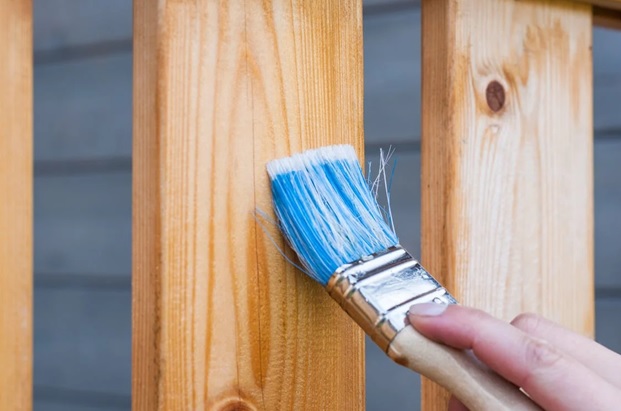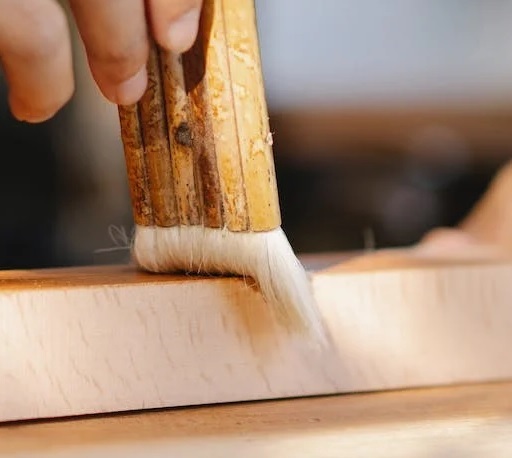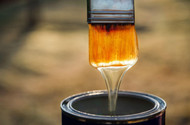Wood Veneer Finishes 101
Mar 22nd 2024
Many species of wood are fairly easy to finish, including oak, beech, fir, pine, and alder veneer, making them highly attractive for a wide range of projects including but not limited to furniture, cabinetry, musical instruments, and much more. Even species like maple and hickory, which can be somewhat difficult to work with, are not always particularly hard to finish.
With that said, here are some of the most common finishes applied to wood veneer.
Penetrating Oils

Penetrating oil is not one specific type of finish, but rather a whole class of wood finishes constituted by oils that seep into and seal off the pores of wood, helping to protect it from oxidation, UV damage, moisture, insect attack, and more.
Common penetrating oils include linseed, danish, tung, and cedar oil. They are easy to apply and often can be applied without a top coat, although without the final seal of such, they will not offer the same level of protection as they might.
Most of these oils can be applied with a cloth or brush and some, like tung and linseed oil, impart a warm glow that will darken with age, enhancing the wood’s natural appearance. They also provide a modicum of protection against insect attack and moisture ingress.
Wax Finishes
Wax finishes are another popular alternative for finishing wood and wood veneer surfaces. The most common type of wax finishing agent is carnauba wax, a hard wax produced from the wax of the leaves of carnauba palm trees, but there are others.
Depending on the product, wax finishes may be applied using a brush or cloth, though some may be sprayed on. They provide a seal to the surface of the wood and a middle-ground level of protection against moisture, UV, and insect attack. They also provide a small degree of protection against abrasion, but unlike penetrating oils, most wax finishes must be reapplied periodically.
Another note is that many wax finishes are capable of producing a keen shine, but for the most part this requires buffing as the first application will often leave a dull and clouded finish.
Shellac
Shellac is a hard topcoat produced from the secretions of an insect known as the lac beetle, suspended in a solvent which evaporates once applied, leaving behind the hard shellac finish.
Shellac is most often sprayed or brushed onto a surface. Brushing can be difficult and a fine-bristled brush, like badger or a varnish brush, is often necessary to leave a smooth surface.
It can leave a glossy finish that will range in color from clear to blond to a rich, warm, dark amber, and often beautifully accentuates the natural grain of species like oak, beech, and walnut.
This makes shellac a good choice for surfaces that might otherwise be difficult to finish, or for those that are difficult to stain, like maple veneer, as it does not penetrate the surface.
However, shellac is not a particularly durable finish and dissolves in alcohol, some solvents, and can even dissolve in water, so it is not recommended for surfaces that will experience a lot of traffic and use.
Lacquer
Lacquer is the name applied to any of several finishes, some derived from urushiol, shellac, nitrocellulose, or the sap or exudates of some trees. Lacquer, which is suspended in a solvent, is usually applied using a brush although it like shellac can also be sprayed on to leave an even finish.
Lacquer is typically clear, but it is often available in matte, medium, and high-gloss finishes. Like shellac, it is a top coat that does not penetrate the wood, but which nonetheless imparts a beautiful luster to the wood’s grain. A common technique is to stain the wood a certain color, or to apply a penetrating oil, and then finish with lacquer on top of that.
Unlike shellac, however, lacquer is physically much more durable and is not miscible in water or alcohol, which means the finish is longer-lasting and provides a higher level of protection to the wood. Because it is so durable, it is often used on furniture, cabinets, paneling, and on other wood surfaces that would experience a lot of traffic.
Polyurethane Finishes
Polyurethane finishes are available in either oil or water based configurations which both offer the same basic attributes. Water-based finishes dry much faster, but both offer a great deal of protection to the wood against water and most other liquids. Polyurethane also protects against weather, offers mild protection against UV degradation, and helps prevent insect and microbial attack.
Polyurethane can be either clear or colored, and is usually applied with a brush. Since it is so physically durable and offers good abrasion resistance, it is desirable for wood products that will experience a lot of traffic or use. It is also one of the finishes that is appropriate for finishing outdoor goods.
Varnish

Varnish is the name given to a variety of different compound finishes which usually contain or consist of resins, solvents, and drying oils, although the exact formulation of each varnish will vary. Some contain shellac, lacquer, polyurethane, acrylic, or a mix of these.
Varnish, like polyurethane and lacquer, usually offers a good deal of wear resistance and some protection against UV, water, and insect attack. Depending on the varnish, it can produce either a glossy to a high-glossy finish. It can be applied by rolling, brushing, or spraying.
Source Oak, Maple, Alder Veneer and More for Your Next Project Here
Whether your next project entails oak, beech, hickory, maple or alder veneer, you can get it here. We sell these species in a variety of cuts and characters, perfect for a wide range of creative projects and applications ranging from cabinets to furniture to speakers and musical instruments.
If you have any questions before you start your next project, or are up in the air about which finish to apply considering the species you’ll be using, get in touch with us at 800-426-6018 and we will be more than happy to help you out.
